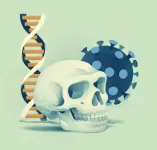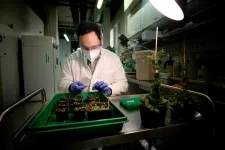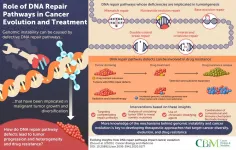Combination treatment for common glioma type shows promise in mice
NIH-funded preclinical study suggests new approach to treat a type of brain tumor
2021-02-16
(Press-News.org) WHAT
Gliomas are common brain tumors that comprise about one third of all cancers of the nervous system. In a study funded by the National Institutes of Health (NIH), researchers tested a novel combination treatment approach on mice with tumors with characteristics similar to human astrocytomas--a type of slow-growing glioma--and found tumor regression in 60 percent of the mice treated. These encouraging results, published in the Journal of Clinical Investigation, could be the first step toward developing a treatment for this type of brain cancer.
Led by senior authors Maria Castro, Ph.D. and Pedro Lowenstein, M.D., Ph.D. along with a team of researchers at the University of Michigan Rogel Cancer Centerb in Ann Arbor specifically tested inhibitors of the compound D-2-Hydroxyglutarate (D-2-HG), which is produced by cancer cells, on a mouse version of astrocytoma carrying mutations in the genes IDH1 and ATRX, along with an inactivated form of the tumor suppressor protein 53 (TP53) gene.
When the implanted mice were treated with a drug to block the production of D-2-HG along with standard of care radiation and temozolomide (chemotherapy) treatments, their survival significantly improved. Looking more closely at tumor cells grown in dishes, the researchers saw that blocking D-2-HG caused the cells to become more susceptible to radiation treatment. However, the treatment also increased the amount of an "immune checkpoint" protein, which tumors use to turn off T cells and evade the immune system.
Inhibiting this immune checkpoint protein with an additional drug resulted in an even greater improvement in survival, because the mouse's own immune system was able to attack the tumor.
Importantly, this combination therapy also led to immunological memory against the glioma, meaning that the mouse now had T cells tailored to the specific tumor. Because gliomas almost always grow back after treatment, these T cells make the animal better prepared to fend off regrowth.
It must be emphasized that these experiments were performed in mice. Nonetheless the preclinical results produced by this combination therapy could represent a key advance in developing an improved treatment regimen, which combines D-2-HG and immune checkpoint inhibition, radiation, and temozolomide, for patients with astrocytomas.
INFORMATION:
WHO
Jane Fountain, Ph.D., program director, National Institute of Neurological Disorders and Stroke
ARTICLE
Kadiyala P. et al. Inhibition of 2-Hydroxyglutarate Elicits Metabolic-reprogramming and Mutant IDH1 Glioma Immunity in Mice. December 17, 2020. Journal of Clinical Investigation. DOI: 10.1172/JCI139542
This study was supported by the NIH (NS091555, NS094804, NS074387, NS076991, NS082311, NS096756, EB022563); Department of Neurosurgery, University of Michigan; Rogel Comprehensive Cancer Center; Pediatric Brain Tumor Foundation; American Brain Tumor Association; Leah's Happy Hearts; and Chad Tough Foundations.
This media availability describes a basic research finding. Basic research increases our understanding of human behavior and biology, which is foundational to advancing new and better ways to prevent, diagnose, and treat disease. Science is an unpredictable and incremental process -- each research advance builds on past discoveries, often in unexpected ways. Most clinical advances would not be possible without the knowledge of fundamental basic research.
NINDS is the nation's leading funder of research on the brain and nervous system. The mission of NINDS is to seek fundamental knowledge about the brain and nervous system and to use that knowledge to reduce the burden of neurological disease.
About the National Institutes of Health (NIH): NIH, the nation's medical research agency, includes 27 Institutes and Centers and is a component of the U.S. Department of Health and Human Services. NIH is the primary federal agency conducting and supporting basic, clinical, and translational medical research, and is investigating the causes, treatments, and cures for both common and rare diseases. For more information about NIH and its programs, visit http://www.nih.gov.
ELSE PRESS RELEASES FROM THIS DATE:
2021-02-16
High levels of public support for strict measures to control COVID-19 during the first wave of the pandemic did not reflect high levels of public trust in the UK government's honesty, transparency or motives, suggests a new study published in PLOS One.
The 'mixed-methods' project, a collaboration between the London School of Hygiene & Tropical Medicine (LSHTM) and University College London (UCL), involved collecting data from more than 9,000 adults living in the UK using an online survey.
It found that during the first wave of COVID-19 (April 2020) 95% of participants were in support of the government having powers to enforce behaviour change. However, only around half (52%) thought that the government was actually doing a good job of controlling COVID-19. Even fewer (36%) thought ...
2021-02-16
New research has found that a group of genes that reduces the risk of developing severe COVID-19 by around 20% is inherited from Neanderthals
These genes, located on chromosome 12, code for enzymes that play a vital role in helping cells destroy the genomes of invading viruses
The study suggests that enzymes produced by the Neanderthal variant of these genes are more efficient which helps protect against severe COVID-19
This genetic variant was passed to humans around 60,000 years ago via interbreeding between modern humans and Neanderthals
The genetic variant has increased in frequency over the last millennium and is now found ...
2021-02-16
Researchers from Skoltech and their colleagues have demonstrated that nanoengineered biodegradable microcapsules can guide the development of hippocampal neurons in an in vitro experiment. The microcapsules deliver nerve growth factor, a peptide necessary for neuron growth. The paper describing this work was published in the journal Pharmaceutics.
Many neurodegenerative conditions that can lead to severe disorders are associated with depleted levels of growth factors in the brain - neuropeptides that help neurons grow, proliferate and survive. Some clinical studies of Alzheimer's and Parkinson's diseases have shown that delivering these growth factors to specific degenerating neurons can have a therapeutic effect. ...
2021-02-16
Scientists from the National Renewable Energy Laboratory (NREL) have developed a simple way to better evaluate the potential of novel materials to store or release heat on demand in your home, office, or other building in a way that more efficiently manages the building's energy use.
Their work, featured in Nature Energy, proposes a new design method that could make the process of heating and cooling buildings more manageable, less expensive, more efficient, and better prepared to flexibly manage power from renewable energy sources that do not always deliver ...
2021-02-16
Last year, researchers at Karolinska Institutet in Sweden and the Max Planck Institute for Evolutionary Anthropology in Leipzig, Germany showed that a major genetic risk factor for severe COVID-19 is inherited from Neandertals. Now the same researchers show, in a study published in PNAS, that Neandertals also contributed a protective variant. Half of all people outside Africa carry a Neandertal gene variant that reduces the risk of needing intensive care for COVID-19 by 20 percent.
Some people become seriously ill when infected with SARS-CoV-2 while others get only mild or no symptoms. In addition to ...
2021-02-16
How do plants build resilience? An international research team led by the University of Göttingen studied the molecular mechanisms of the plant immune system. They were able to show a connection between a relatively unknown gene and resistance to pathogens. The results of the study were published in the journal The Plant Cell.
Scientists from "PRoTECT" - Plant Responses To Eliminate Critical Threats - investigated the molecular mechanisms of the immune system of a small flowering plant known as thale cress (Arabidopsis thaliana). PRoTECT ...
2021-02-16
The ongoing health disaster of the past 12 months has exposed the crises facing nursing homes in Canada and the United States and the struggles of the staff working in them.
Writing in the Journal of Comparative Policy Analysis: Research and Practice, PhD student Daniel Dickson, his supervisor Patrik Marier, professor of political science, and co-author Robert Henry Cox of the University of South Carolina perform a comparative analysis of those workers' experiences. In it, they look at Quebec (including those at government-run CHSLDs), British Columbia, Washington State and Ohio ...
2021-02-16
Hamilton, ON (February 16, 2021) - A McMaster stem cell research team has made an important early step in developing a new class of therapeutics for patients with a deadly blood cancer.
The team has discovered that for acute myeloid leukemia (AML) patients, there is a dopamine receptor pathway that becomes abnormally activated in the cancer stem cells. This inspired the clinical investigation of a dopamine receptor-inhibiting drug thioridazine as a new therapy for patients, and their focus on adult AML has revealed encouraging results.
AML is a particularly deadly cancer that starts with a DNA mutation in the blood stem cells of the bone marrow that produce too many infection-fighting white blood cells. According ...
2021-02-16
The ongoing fight of science against cancer has made great strides, but cancer cells have not made it easy. The complexity of cancer cells and their adaptive evolutionary nature complicate the search for effective cures. Multiple DNA repair pathways in healthy cells typically work to rectify DNA damages caused by sources within the organism, like spontaneous DNA mutations, or from outside, like ultraviolet radiation.
But what happens when these pathways malfunction? It is known that deficiencies in these pathways increase the instability of the genes, and this causes cancer to develop. Therefore, detailed knowledge of how DNA repair pathways participate in this process is crucial for tracking tumor progression, understanding the emergence of drug ...
2021-02-16
Melanoma is by far the deadliest form of skin cancer, killing more than 7,000 people in the United States in 2019 alone. Early detection of the disease dramatically reduces the risk of death and the costs of treatment, but widespread melanoma screening is not currently feasible. There are about 12,000 practicing dermatologists in the US, and they would each need to see 27,416 patients per year to screen the entire population for suspicious pigmented lesions (SPLs) that can indicate cancer.
Computer-aided diagnosis (CAD) systems have been developed in recent years to try to solve this problem by analyzing images of ...
LAST 30 PRESS RELEASES:
[Press-News.org] Combination treatment for common glioma type shows promise in mice
NIH-funded preclinical study suggests new approach to treat a type of brain tumor




